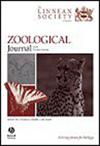A new dentition-based phylogeny of Litopterna (Mammalia: Placentalia) and ‘archaic’ South American ungulates
IF 2.8
2区 生物学
Q1 ZOOLOGY
引用次数: 0
Abstract
Ever since the discovery of Macrauchenia patachonica by Charles Darwin in 1834, the affinities of litopterns—a group of extinct South American Native Ungulates (SANUs)—have been elusive. In particular, the interfamilial relationships and timing of the familial diversification within the order Litopterna have not been addressed with adequate taxon and character sampling, and modern phylogenetic methods. We address these issues using a new morphological matrix of 703 dental and mandibular characters, scored for the earliest litopterns alongside early SANUs of other orders (Astrapotheria, Notoungulata, Pyrotheria, and Xenungulata). We also included members of families that have been often included within Litopterna, such as Didolodontidae, Protolipternidae, Indaleciidae, and Notonychopidae, the last two sometimes grouped in the order Notopterna. We conducted maximum parsimony and undated and tip-dated Bayesian phylogenetic analyses. Our results indicate that (1) didolodontids, protolipternids, and kollpaniines should be considered early SANUs, but not particularly closely related to any order, (2) Indaleciidae and Notonychopidae usually form a monophyletic group (Notopterna), and (3) Litopterna is a monophyletic unit composed of four families [Adianthidae, Anisolambdidae (subfamilies Anisolambdinae and Sparnotheriodontinae), Macraucheniidae, Proterotheriidae], and tentatively the notoptern families Indaleciidae and Notonychopidae with a probable origin ~64.0 Mya in the Early Palaeocene.基于牙齿的Litopterna(哺乳纲:胎生目)和 "古老的 "南美洲有蹄类动物的新系统发育
自 1834 年查尔斯-达尔文发现 Macrauchenia patachonica 以来,有蹄类动物--一类已灭绝的南美洲原生有蹄类动物(SANUs)--的亲缘关系一直难以捉摸。特别是,我们还没有通过充分的分类群和特征取样以及现代系统发育方法来研究栗蛙目内部的家族间关系和家族分化的时间。我们使用了一个包含 703 个牙齿和下颌骨特征的新形态矩阵来解决这些问题,该矩阵为最早的石龙子目和其他目(Astrapotheria、Notoungulata、Pyrotheria 和 Xenungulata)的早期 SANUs 一起评分。我们还将一些经常被归入石龙子目的科(如Didolodontidae、Protolipternidae、Indaleciidae和Notonychopidae)的成员包括在内,后两个科有时被归入Notopterna目。我们进行了最大解析以及无日期和有尖端日期的贝叶斯系统发育分析。我们的结果表明:(1)didolodontids、protolipternids和kollpaniines应被视为早期的SANUs,但与任何目都没有特别密切的关系;(2)Indaleciidae和Notonychopidae通常形成一个单系群(Notopterna)、(3) Litopterna 是一个单系单元,由 4 个科组成[Adianthidae, Anisolambdidae(亚科 Anisolambdinae 和 Sparnotheriodontinae), Macraucheniidae, Proterotheriidae],暂定为啄木鸟科 Indaleciidae 和 Notonychopidae,可能起源于 ~64.0万年前的早古新世。
本文章由计算机程序翻译,如有差异,请以英文原文为准。
求助全文
约1分钟内获得全文
求助全文
来源期刊
CiteScore
6.50
自引率
10.70%
发文量
116
审稿时长
6-12 weeks
期刊介绍:
The Zoological Journal of the Linnean Society publishes papers on systematic and evolutionary zoology and comparative, functional and other studies where relevant to these areas. Studies of extinct as well as living animals are included. Reviews are also published; these may be invited by the Editorial Board, but uninvited reviews may also be considered. The Zoological Journal also has a wide circulation amongst zoologists and although narrowly specialized papers are not excluded, potential authors should bear that readership in mind.

 求助内容:
求助内容: 应助结果提醒方式:
应助结果提醒方式:


